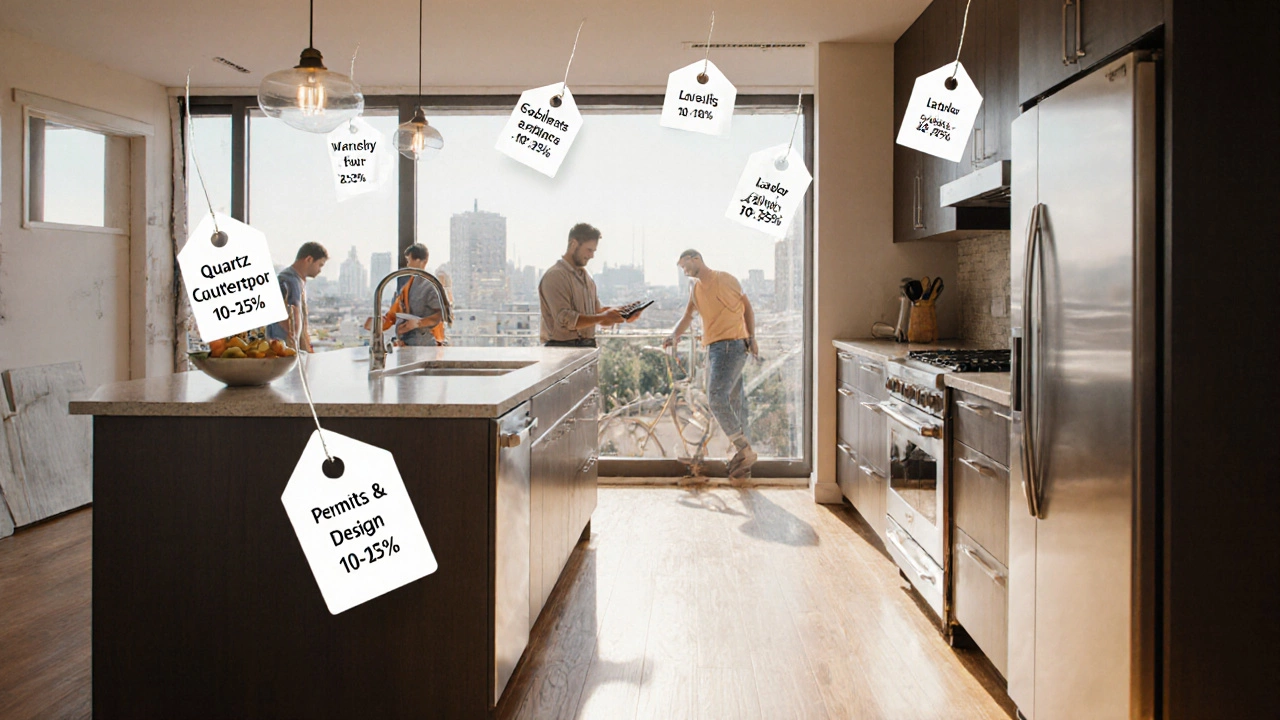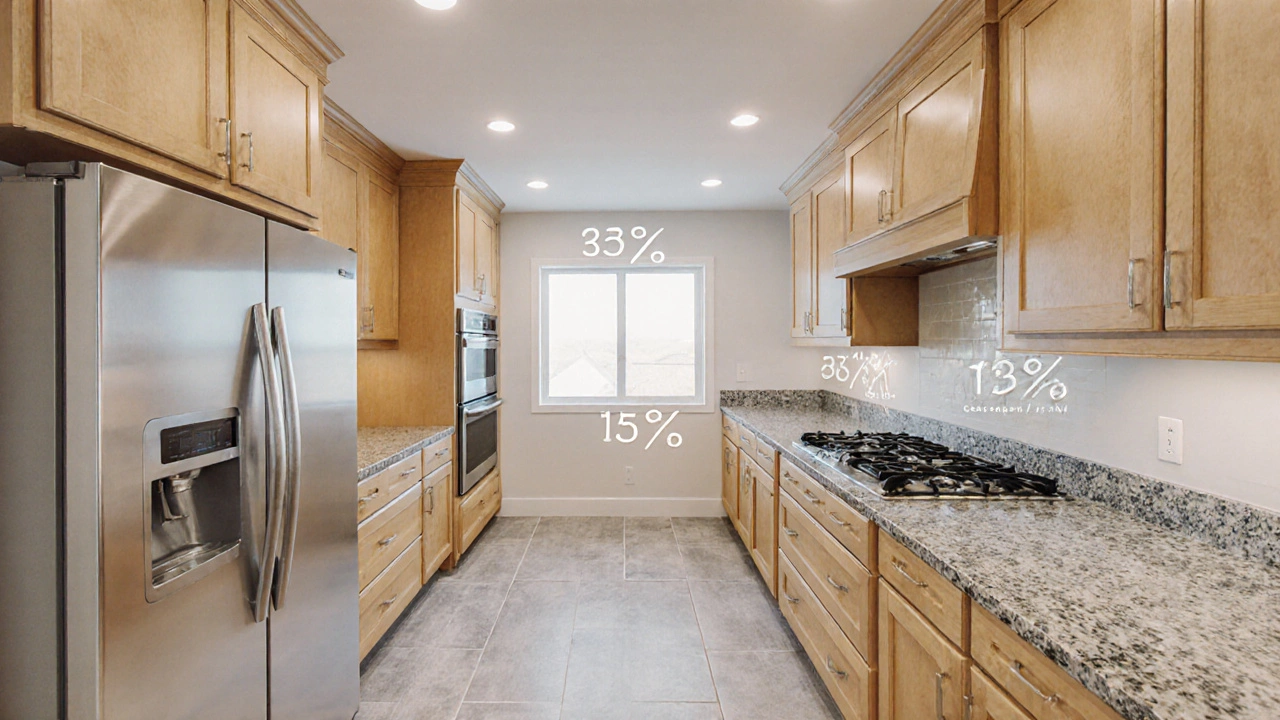Realistic Kitchen Remodel Budget Guide 2025
 Oct, 19 2025
Oct, 19 2025
Kitchen Remodel Budget Calculator
Estimate your kitchen remodel costs based on the 2025 budget guide. Enter your target budget and see how it breaks down across key components.
Thinking about a new kitchen but worried about the price tag? You’re not alone. Homeowners often stumble when they try to guess how much a full kitchen remodel will actually cost. Below you’ll find a step‑by‑step roadmap that turns vague guesses into a concrete, realistic budget you can trust.
When you hear the phrase kitchen remodel budget, most people picture a single number. In reality, the budget is a blend of materials, labour, permits and a few surprise costs that pop up mid‑project. Knowing where each dollar goes makes the whole process less stressful and keeps the project on track.
What Drives the Cost of a Kitchen Remodel?
The first thing to understand is that a kitchen remodel isn’t just about swapping out a few cabinets. It’s a collection of separate cost centres that add up. Below are the seven major drivers, each introduced with schema.org microdata so search engines can recognise them.
Kitchen cabinets are typically the single biggest expense, accounting for 30‑35% of the total. Custom‑made units can cost double the price of stock options, while ready‑to‑assemble (RTA) models are the most budget‑friendly.
Countertops range widely in price. Laminate is the cheapest, while natural stone such as granite or quartz can push the cost per square foot well above $150 NZD.
Appliances include the stove, oven, fridge, dishwasher and possibly a microwave. High‑end, smart appliances add a premium, whereas reliable mid‑range models give a solid balance of performance and cost.
Labor costs cover carpenters, electricians, plumbers and finish‑carpenters. Labour typically represents 20‑25% of the total budget, but can spike if you need multiple trades working simultaneously.
Permits are mandatory for any structural changes, new plumbing or electrical upgrades. In Wellington, a standard kitchen remodel permit can run $800‑$1,200 NZD, but larger structural alterations may cost more.
Design services add professional expertise, helping you avoid costly mistakes. A designer’s fee usually falls between 5‑10% of the total project cost.
Flooring in the kitchen must be durable and water‑resistant. Vinyl, engineered wood and ceramic tiles each have distinct price points and installation requirements.
Budget Tiers: What $10,000, $30,000 and $60,000 Can Get You
Most homeowners fall into three budget categories: low‑end, mid‑range and high‑end. Below is a quick comparison of what you can typically expect at each level in New Zealand dollars.
| Tier | Typical Range | Cabinets | Countertops | Appliances | Labor & Permits |
|---|---|---|---|---|---|
| Low‑end | $10,000‑$15,000 | RTA or pre‑finished stock | Laminate or low‑cost solid surface | Budget stainless steel or basic electric range | DIY‑heavy, minimal permits |
| Mid‑range | $30,000‑$45,000 | Semi‑custom or high‑grade stock | Quartz or mid‑grade granite | Mid‑level fridge, dishwasher, gas cooktop | Professional installation, standard permits |
| High‑end | $60,000‑$100,000+ | Fully custom, premium hardwood | Natural stone, high‑end engineered quartz | Smart appliances, high‑efficiency models | Full‑service design, multiple trades, extensive permits |
How to Calculate Your Own Kitchen Remodel Budget
- Measure the space. Note wall lengths, ceiling height, window and door locations. Accurate square footage is the foundation for material estimates.
- Set a target total. Decide how much you can realistically spend without dipping into emergency savings. A common rule is to keep the remodel under 15% of your home’s market value.
- Breakdown by category. Use the percentages above (cabinets 30‑35%, countertops 10‑15%, appliances 10‑15%, labor 20‑25%, permits & design 10‑15%). Multiply each percentage by your total target to get a preliminary allocation.
- Get quotes. Contact at least three suppliers for cabinets, countertops and appliances. For labour, request detailed estimates from licensed contractors, ensuring they include plumbing, electrical and waste removal.
- Add a contingency. A 10‑15% buffer protects you from hidden costs such as unexpected wiring upgrades or water damage.
Once you have numbers for each line‑item, add them up and compare the sum to your target total. If you’re over, trim the lowest‑impact areas first-perhaps switch from quartz to high‑grade laminate or postpone an upscale lighting plan.

Stretching Your Dollars: Smart Ways to Save
- Do‑it‑yourself where possible. Installing backsplashes, painting walls, or even assembling RTA cabinets can shave 15‑20% off labour costs.
- Shop off‑season. Suppliers often discount cabinets and countertops between May and August, when demand drops.
- Consider recycled or reclaimed materials. Reclaimed wood for island tops or salvaged steel for backsplashes adds character and reduces material spend.
- Opt for modular layouts. Keeping the existing kitchen footprint avoids costly structural changes and permits.
- Leverage government rebates. In New Zealand, certain energy‑efficient appliances qualify for the Energy Efficiency and Conservation Authority (EECA) rebate, which can offset up to $500 per appliance.
Hidden Costs You Might Overlook
Even the best‑planned budget can be derailed by surprise expenses. Keep an eye on these common hidden costs:
- Unexpected plumbing issues. Old pipes that need replacement can add $1,000‑$3,000.
- Electrical upgrades. Adding new circuits for high‑wattage appliances may require a permit and a licensed electrician.
- Demolition and disposal. Removing old cabinets and countertops often costs $500‑$1,200, especially when hazardous materials like asbestos are involved.
- Floor leveling. Uneven sub‑floors require sanding or resurfacing before new flooring can be installed.
- Change orders. Small tweaks after work begins-like a different hardware finish-can quickly add up.

Sample Budget Breakdown for a Mid‑Range Remodel
Imagine a 12‑person‑hour family in Wellington planning a mid‑range overhaul with a $35,000 target.
- Cabinets (35%): $12,250 - semi‑custom maple with soft‑close drawers.
- Countertops (13%): $4,550 - quartz slab (approx. $150 per sq ft).
- Appliances (12%): $4,200 - mid‑range fridge, dishwasher, gas cooktop, convection oven.
- Labor (24%): $8,400 - carpentry, plumbing, electrical, flooring.
- Permits & Design (10%): $3,500 - city permit, 2‑hour design consulting.
- Contingency (6%): $2,100 - set aside for unexpected plumbing.
The total lands at $35,000, matching the original target. Adjust any line‑item up or down and the overall figure follows suit.
Pre‑Remodel Checklist
- Confirm your financing (home equity loan, savings, or renovation line of credit).
- Secure permits from Wellington City Council.
- Finalize design drawings and material selections.
- Sign contracts with clear payment milestones.
- Arrange a temporary kitchen setup (e.g., portable burners, fridge on wheels).
- Schedule a walk‑through with the contractor before demolition.
Crossing these boxes keeps the project on time and on budget.
Frequently Asked Questions
How much should I set aside for a kitchen remodel in Wellington?
A realistic range is $10,000‑$15,000 for a budget‑friendly update, $30,000‑$45,000 for a mid‑range remodel, and $60,000 or more for a high‑end renovation. Your exact number depends on material choices, labour rates and whether you need structural changes.
Do I need a permit for all kitchen remodels?
Any work that involves moving walls, changing plumbing, or altering electrical circuits requires a building consent from the Wellington City Council. Cosmetic updates like paint or new cabinet fronts usually do not need a permit.
Can I save money by doing the work myself?
Yes. Tackling demolition, painting, or installing a backsplash can cut labour costs by 15‑20%. However, leave plumbing, electrical and structural work to licensed professionals to avoid costly re‑work or code violations.
What’s the biggest surprise cost homeowners encounter?
Hidden plumbing problems are the most common. Old pipework that needs replacement can add $1,000‑$3,000 to the tally, especially if you discover leaks after the walls are opened.
How can I make my remodel more energy‑efficient?
Choose ENERGY STAR appliances, LED lighting, and low‑flow faucets. Newer induction cooktops also use less electricity than traditional electric ranges. You may qualify for EECA rebates that offset up to $500 per appliance.
